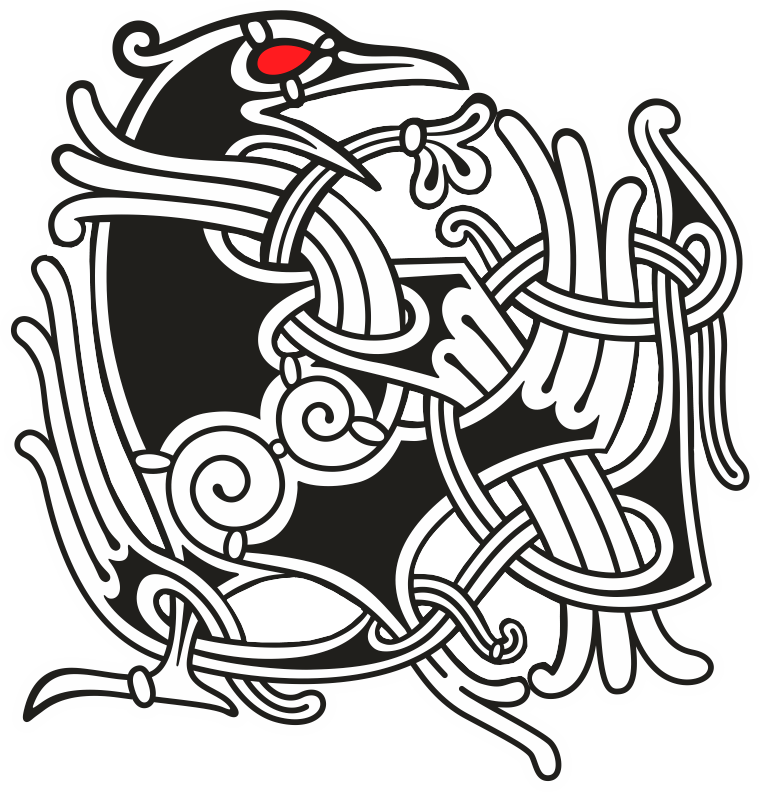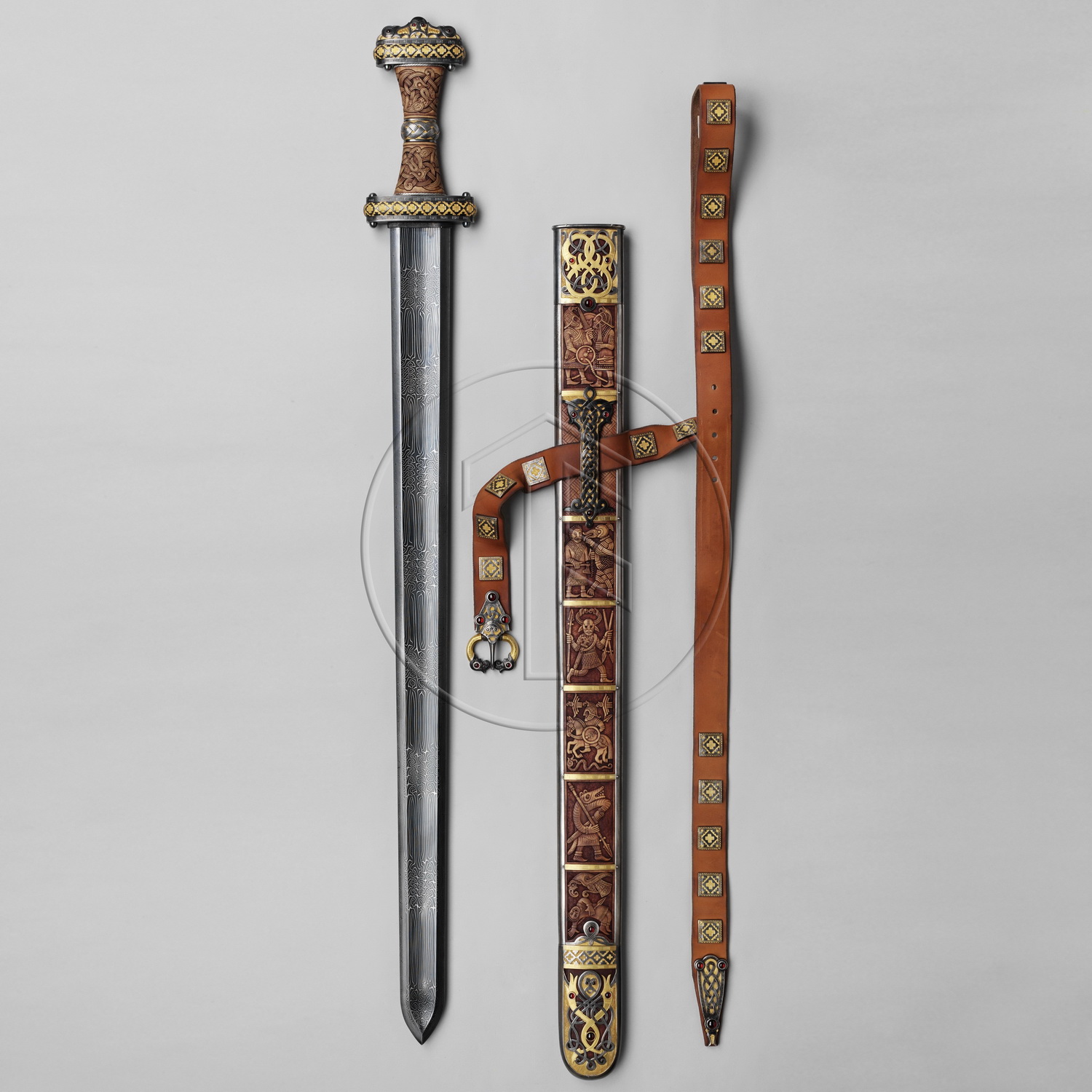Sword Meroving
A blade of mosaic damask steel (after the image of Sutton Hoo), the design of which is an exquisite ornament. For the hilt, materials such as boxwood and oxidized silver were used. The low toned relief, skillfully carved into the boxwood, refers us to the complex Germanic «braids» with anthropomorphic motives. Interception of the handle is a simpler silver triple «braid» on a gold background; the crosshair and pommel are decorated with gold ornamentation of equal-pointed crosses (recall here the mystical sign of the Merovingians). The head of the sword is an anthropomorphic mask with almandine eyes, which is a direct quote from Celtic (mask) and Gothic (pomegranate eyes) arts and crafts.
The sword scabbard, made in the same materials and techniques, deserves no less attention: carved tinted boxwood, silver, gold. There are six low reliefs along the entire length of the scabbard. The images on them were borrowed from genuine monuments of the Wendel period — silver plates from helmets found during excavations in Wendel (Middle Sweden, turn of the 6th-7th centuries) and in the burial of Sutton Hoo (England, Suffolk, 530s after Bruce-Mitford ). All images are of a «magical» nature, associated with the warrior theme of Scandinavian mythology, in particular — the scene of the capture of Fenrir, when Tyr (the god of military valor) bound the Wolf with a magic chain; the image of a «dancing warrior» in a «horned» helmet — perhaps this is a special interpretation of the image of Odin in combination with the image of the god of the earth, which is found in the Celtic tradition. The image of a werewolf itself may be an echo of totemism and an attempt to attract the inhuman power of a mythical creature to the owner of the sword; however, this image, like the «dancing warrior», is borrowed from the matrix from Torslund, which most likely illustrates the legend of how Odin was killed by the freed Fenrir on the day of Ragnarok (the death of the gods). On the sheath of the Merovingian Sword, the werewolf and the warrior are separated, and between these reliefs is placed the figure of a horseman-spearman in a «horned» helmet, accompanied by two ravens and trampling a snake; researchers tend to interpret it as the image of Odin. The lower relief represents a warrior pierced by a spear, to whom an eagle descends. Scenes of a man being tormented by an eagle are practically not found in Scandinavian art; the assumption that the image of an eagle is associated with the image of Odin (two eagles are his companions) has a right to exist, and before us is the moment when the one who died in battle prepares to go to Valhalla, where valiant warriors always feast, where the rumble of those who remember their valiant exploits, because for a warrior the best death is in battle.
The mouth and the tip of the scabbard are decorated with silver and gold braids with zoomorphic and anthropomorphic motifs, inlaid with almandine eyes and decorated with engraving; on the edge of the arrowhead there is also the familiar ornament of equal-pointed crosses.
On the upper bar of the scabbard, there is a belt clip, traditional for medieval edged weapons, made of silver and gold, inlaid with almandines and designed as a zoomorphic braid, the ends of which end with stylized snake heads. A leather belt is threaded through the bracket, on which there are silver and gold lining with single motifs of the equal-pointed «Merovingian» cross. The tip made of the same materials is a silver braid on a gold background with three almandine eyes. Buckle cover includes anthropomorphic mask in its decor; the buckle ring is designed in the form of two snakes with golden bodies and almandine eyes on silver heads.
So, the Merovingian Sword is a rather interesting example of how elements borrowed from the monuments of decorative and applied arts from different regions can be combined in one piece quite organically; in addition, the technical characteristics of the original items are repeated here, which gives the item a special value. At the same time, the sword is not a simple compilation: the prototype monuments have to a certain extent been rethought and creatively reworked by modern authors, therefore their work is a magnificent reconstruction. Probably, the mythical Sigurd or any of the legendary Merovingians would not refuse to wield such a sword, and to receive such a sword as a reward would be a great honor for any warrior. And, perhaps, the Sword «Merovingian» is worthy of scaldic Kenning epithets — «thundering fire of chain mail», «ray of battles», «best friend in battle.»
Material: Masa Damascus steel, silver, gold, garnets, boxwood, leather.
Techniques of execution: Forging, polishing, investment casting, soldering, mounting, engraving, embossing, occasional gilding, all-cutting.
Overall size: 970 mm
Length without scabbard: 937 mm
Stick length: 187 mm
Blade length: 747 mm
Blade width: 55-40 mm
Blade thickness: 6-5 mm
Scabbard length: 783 mm




